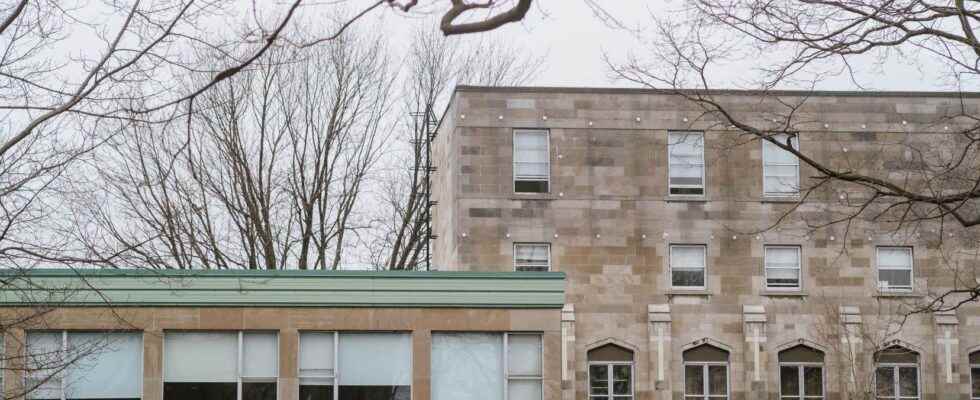An inspection carried out last week by the Commission for Standards, Equity, Health and Safety at Work (CNESST) at the Sophie-Barat school reveals a risk of exposure to asbestos dust at several locations in the facility where ceiling tiles were damaged or missing, learned The duty.
The inspection was carried out on September 15 in the main school building located in the Ahuntsic district following a complaint about the “presence of asbestos and mold”.
According to the report that The duty was able to consult, the presence of asbestos had already been detected in 2014 by the firm Les Services EXP Inc., in particular in the cement plaster of the walls and between the ceilings, in the gypsum joint cement, in the mechanical room and in the insulating material of the boiler room. At the time, annual or biannual inspections were recommended.
During his visit, the CNESST inspector, François Tremblay, however noted that in several rooms, namely the weight room, the corridor on the second floor and the one on the 3rd floor, acoustic ceiling tiles had holes or had been removed without being replaced. “Although no dust from the ceiling space is visible in these premises, […] these openings in the suspended ceiling could represent a risk that asbestos dust could fall to the floor”, notes the author of the report.
The document also mentions that work has recently been carried out in Classroom 317 where new walls have been built. To do this, the suspended ceiling was partially removed, exposing the between-ceiling, noted the CNESST inspector. On two sides of the room, he notes an opening with a width of 50 cm over a few meters. Some sections of the ceiling are damaged, he says.
However, the presence of asbestos had previously been reported in the joint compound of the gypsum panels in the ceiling space. The inspector did not find any asbestos dust, but he believes that the openings in the ceiling present a risk of exposure if dust were to come off the damaged places.
Non-conformities
The report even mentions that some workers in the material resources department do not take precautions to protect themselves against asbestos dust when moving acoustic tiles and that they do not replace the tiles when they leave.
Faced with these “non-conformities”, the inspector asks the establishment to close the suspended ceiling of the room in question. A school manager has also agreed that the room will be made inaccessible until the suspended ceiling has been replaced.
An asbestos safety management action plan is also required and the inspector asks that the asbestos safety management register be made available to workers, which had not been done before.
The inspection was carried out in the presence of Gabrielle Bianco, toxicologist from the Montreal Regional Public Health Department. Another inspection will be carried out at a later date.
The flood of September 13
The inspector was also interested in the risks of exposure to mould. During the deluge on September 13, water seeped into two basement rooms, the weight room and the concierge room, which wet the floors.
According to school officials, no water damage has occurred in recent years, apart from leaking radiators, but the inspector found traces of old water flows on ceiling tiles at several places in the facility. Only one “minor” trace of mold was observed by the inspector.
The Sophie-Barat school is in a poor state. In the fall of 2020, a wing of the main building that was in danger of collapsing was urgently closed. The cafeteria and the library had then been condemned. Hundreds of students had to be educated elsewhere. The school must also be the subject of a vast renovation and expansion project, the cost of which is estimated at 164.5 million dollars.
Fixes made
The Center de services scolaire de Montréal (CSSDM) indicates that it is collaborating “fully” with the CNESST inspectors and specifies that all the corrective measures requested have been carried out or are in the process of being carried out. Work is complete in room 317 and the replacement of damaged tiles throughout the building has already begun and will be completed early next week, said Alain Perron, CSSDM press relations manager, in an email.
“There is no compromise when it comes to user safety,” he added. “The corrective measures requested by the CNESST are preventive measures with which we comply. Rigorous inspections take place regularly at the Sophie-Barat school and interventions are carried out quickly when problems are detected. »
Predictable concern
The presence of asbestos at the Sophie-Barat school does not surprise Sylvain Martel, spokesperson for the Regroupement des Comités de Parents Autonomes du Québec (RCPAQ). “If we made an inventory of all the public buildings that have asbestos, there would be quite a few,” he says.
However, he is concerned about the fact that certain precautions did not seem to have been taken in the context where the presence of asbestos was already known. “It is sure that it risks creating insecurity among the parents,” he said. “We are in a register of perceptions and that is hard to manage. »
“The case of the Sophie-Barat school illustrates the failure of the CSSDM, estimates Catherine-Beauvais-St-Pierre, president of the Alliance of teachers and teachers of Montreal. We are not in the recommendations, but in the urgency to act. »
The Sophie-Barat school team has been hard hit in recent years and several staff members have left the establishment due to the difficult context, she recalled. “It seems to me that we should redouble our efforts so that teachers feel safe in their environment and that they can do their job without having concerns about their health and safety. »
With Marco Fortier
